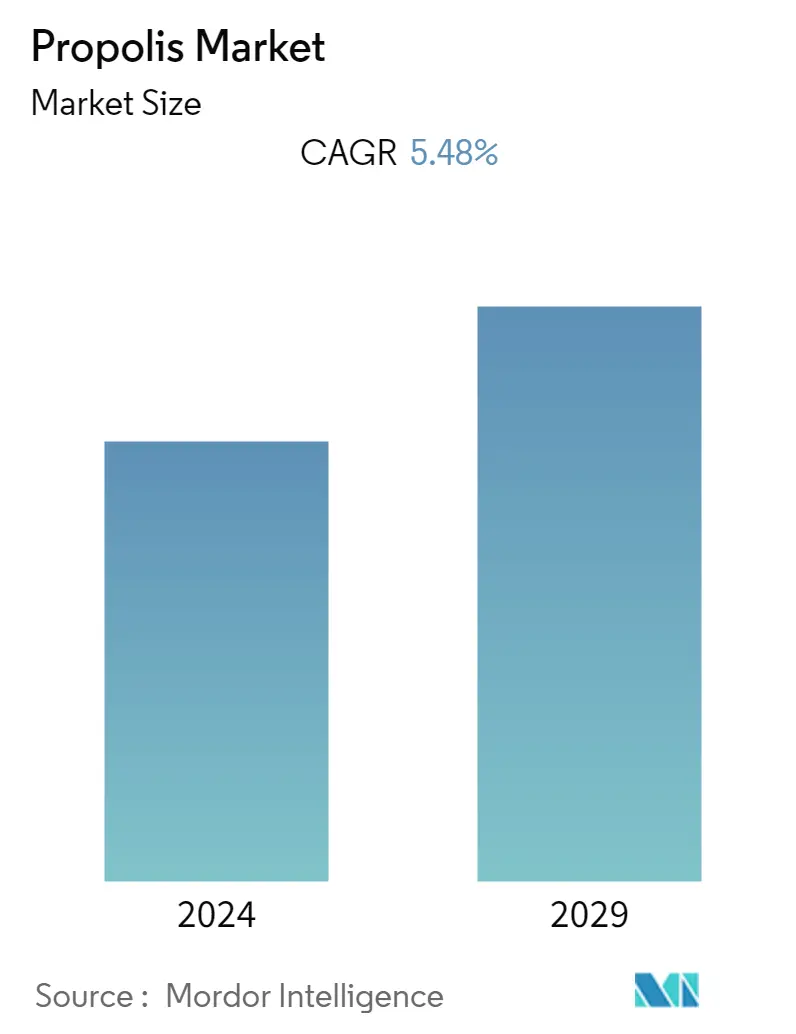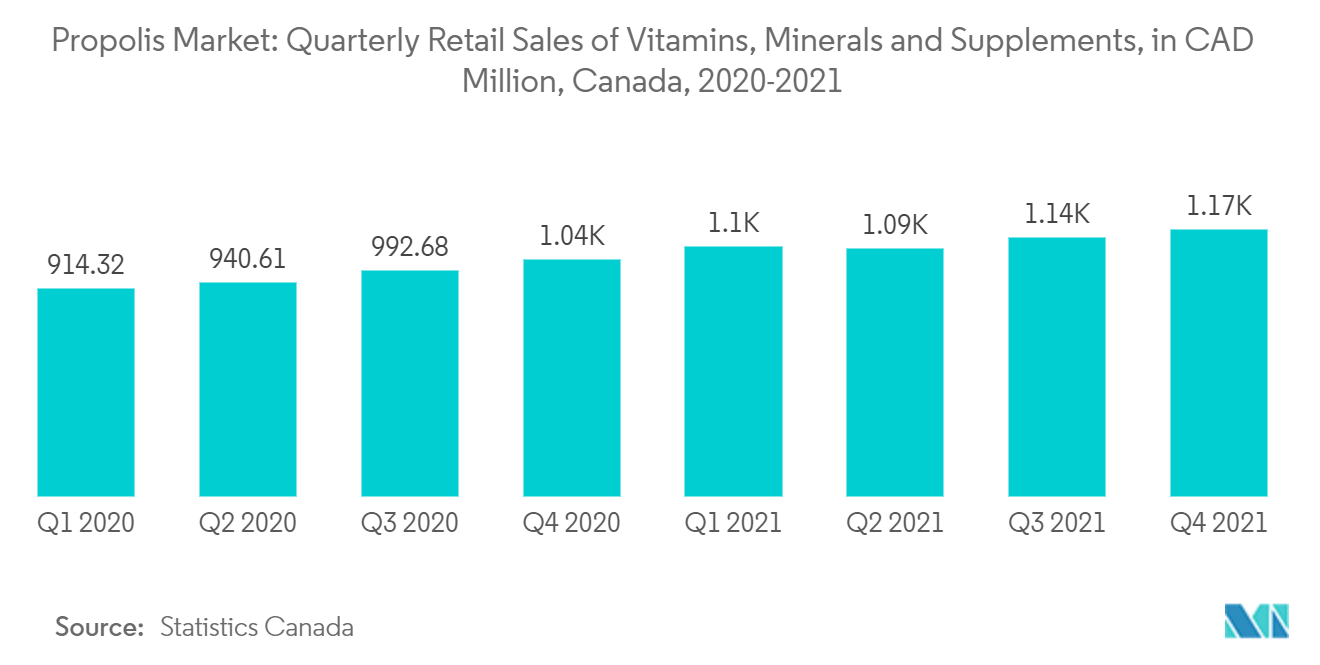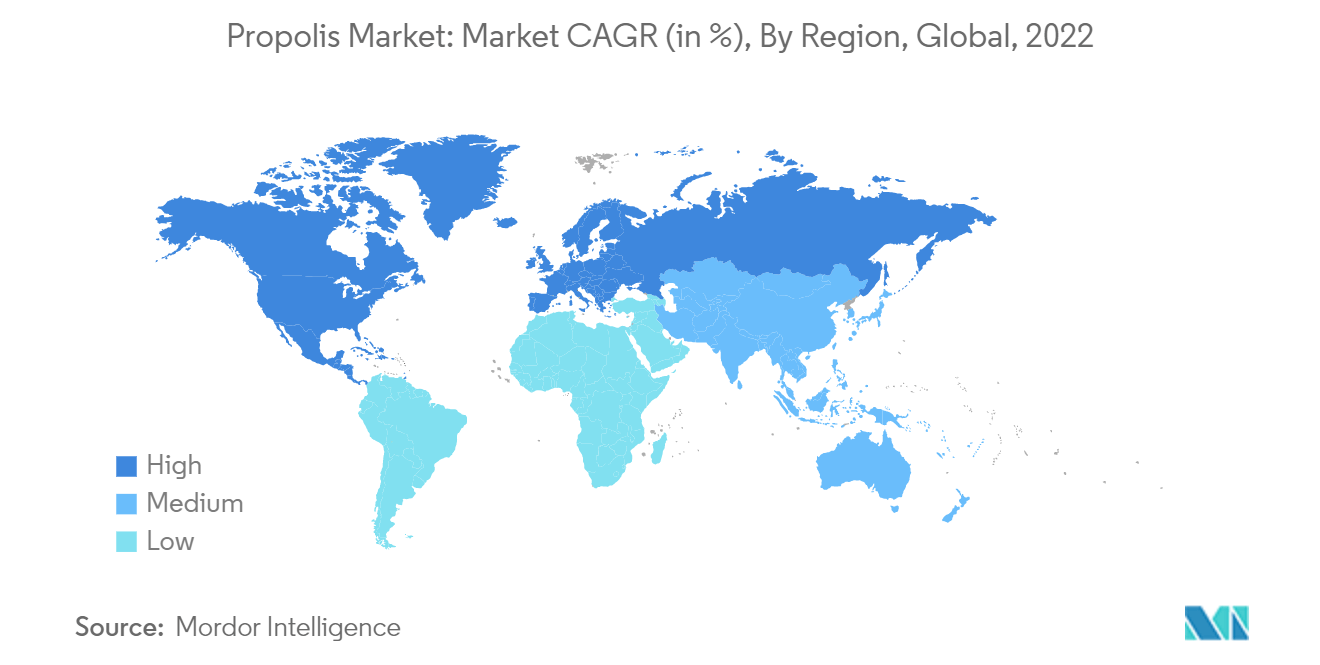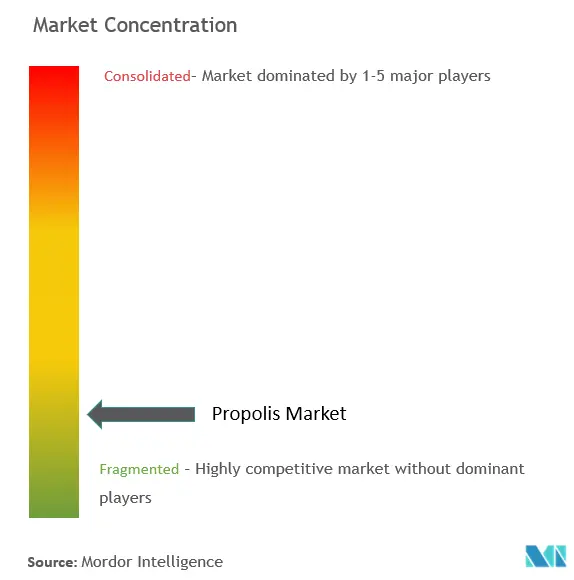Propolis Market Size

| Study Period | 2019 - 2029 |
| Base Year For Estimation | 2023 |
| CAGR | 5.48 % |
| Fastest Growing Market | Middle-East and Africa |
| Largest Market | Europe |
| Market Concentration | Low |
Major Players.webp)
*Disclaimer: Major Players sorted in no particular order |
Need a report that reflects how COVID-19 has impacted this market and its growth?
Propolis Market Analysis
The Propolis Market size is expected to grow from USD 675.46 million in 2023 to USD 881.96 million by 2028, at a CAGR of 5.48% during the forecast period (2023-2028).
The COVID-19 pandemic led to the increased demand for propolis for its functional properties. However, the supply chain of the market studied was vastly affected by the falling production of propolis as an ingredient. The COVID-19 lockdown has presented a peculiar problem for beekeepers and bees. As countries go into extended lockdowns, the movement of non-essential vehicles has come to a standstill. Consequently, bee farmers found it difficult to move their bee boxes from one place to another, both cross-country and internationally, which resulted in bees starving to death; this reduced bee pollination and the production of propolis. Moreover, the availability of limited labor power further impacted the production of end products, negatively impacting the propolis market.
Over the long term, propolis intake strengthens the immune system, simultaneously serving as an antioxidant, anesthetic, and wound healer, which makes it an important component of the pharmaceutical sector.
One of the challenges while purchasing propolis is the lack of standardization across available brands. Many brands state they are made from 20% pure propolis. However, this does not inform the consumer of the quality of that 20%. Such a drawback in information transparency might restrain the growth of the market.
Propolis Market Trends
Rising Demand for Supplements Including Antioxidants
The multifunctional attributes of antioxidants, specifically the one inducing younger skin and facial aesthetics, have been primarily drawing consumer interest toward food and beauty products incorporating all sources of antioxidants, including the potentially growing propolis. Researchers have identified more than 300 compounds in propolis, the majority of which are found to be forms of polyphenols. Polyphenols being antioxidants, help fight disease and damage prompted in the body. There has been a rise in demand for various health supplements across the globe over the past few years owing to the increase in awareness of the health benefits provided by the same. For instance, as per the data published by Statistics Canada, in the fourth quarter of 2021, sales of vitamins, minerals, and other dietary supplements totaled over CAD 1.17 billion.
Additionally, propolis contains polyphenols called flavonoids, which constitute a great antioxidant source. More consumers are willing to include antioxidants in their daily intake, and so the growing prevalence of the ingredient in beauty and health supplements, propolis capsules, and extracts is anticipated to gain traction and witness a flourishing growth in sales during the forecast period. For instance, Red Bee Propolis by Natura Nectar is among the well-known propolis supplements claiming to provide one of nature's most powerful antioxidants even higher than super-fruits.

Europe Holds the Largest Market Share
The growing demand for propolis in Europe can be attributed to rising health awareness and its ability to boost the immune system and digestive health and reduce wrinkles among adults. Additionally, propolis is a gluten-free product that can be used by people suffering from celiac disease. As per The Ministry of Health Italy, in 2021, there were about 242 thousand cases of celiac disease across the nation. Such factors also play a crucial role in driving the market studied.
As per the World Bank Data, 18.92% were over 65 in 2021. The rise in the elderly population and the ability to spend more on healthcare products is expected to augment market growth. On account of their nutritional and health benefits, they are widely used to boost immunity. Additionally, based on epidemiological and preclinical studies, propolis has a chemo-preventive activity, which decreases the risk of cancer. As per the data from Cancer Research United Kingdom, every two minutes, someone in the United Kingdom is diagnosed with cancer. The rising cancer incidence among the British people and evidence from clinical studies aid the propolis market growth.
Moreover, the growing consumer interest in certified organic products on account of the rising concerns around the presence of metals, impurities, and microbial contamination has led to various manufacturers labeling the product as organic. For instance, Herbiolys Laboratoire is among the domestic producers and marketers of propolis in France having the product labeled as vegan and organic. Such initiatives by the players have been gaining consumers trust and burgeoning the market growth.

Propolis Industry Overview
The use of propolis is taking place at a huge scale since the disclosing of associated healthcare benefits. Manufacturers from countries like Brazil, New Zealand, China, Russia, and Turkey are introducing the extraction of propolis on an industrial scale. The market studied is fragmented in nature owing to the large number of players operating in the global propolis market. The products are visible in the market in the form of capsules, sprays, and extracts. The market's major players are Comvita Ltd, Wax Green, Innovations in Nutrition + Wellness, Apiário Polenectar, and Apis Flora. The strategy for partnerships, joint ventures, and mergers has been the crucial strategy behind the development of these companies in the global market scenario. Over the past few years, expanding the market presence to emerging economies has been a key strategy behind the growth of major companies. However, key market players are focusing on building and sustaining their brand image through advertising, sample distribution, and brand promotion.
Propolis Market Leaders
Wax Green
Apis Flora
Apiário Polenectar
Innovations in Nutrition + Wellness
Comvita Ltd.
*Disclaimer: Major Players sorted in no particular order

Propolis Market News
- In September 2021, Comvita Ltd announced a strategic partnership with Caravan, a joint venture with entertainment and sports agency, Creative Artists Agency (CAA). The new partnership with Caravan will help increase consumer awareness about the benefits of Mānuka Honey and Propolis by forming a celebrity-backed lifestyle brand using the natural healing properties of Mānuka Honey and Propolis for topical use.
- In March 2021, Innovations in Nutrition + Wellness (INW) announced that it had acquired Bee Health, the United Kingdom's leading developer and manufacturer of nutritional supplements. INW and Bee Health's highly complementary product capabilities and geographical scope will further enhance the services provided to brand partners.
- In March 2021, Comvita officially opened of its state-of-the-art Wellness Lab experiential space in the Viaduct, Auckland.
Propolis Market Report - Table of Contents
1. INTRODUCTION
1.1 Study Assumptions and Market Definition
1.2 Scope of the Study
2. RESEARCH METHODOLOGY
3. EXECUTIVE SUMMARY
4. MARKET DYNAMICS
4.1 Market Drivers
4.2 Market Restraints
4.3 Porter's Five Forces Analysis
4.3.1 Threat of New Entrants
4.3.2 Bargaining Power of Buyers/Consumers
4.3.3 Bargaining Power of Suppliers
4.3.4 Threat of Substitute Products
4.3.5 Intensity of Competitive Rivalry
5. MARKET SEGMENTATION
5.1 Product Type
5.1.1 Capsules and Tablets
5.1.2 Liquids
5.1.3 Creams
5.1.4 Other Product Types
5.2 Distribution Channel
5.2.1 Offline Retail Stores
5.2.1.1 Supermarkets/Hypermarkets
5.2.1.2 Pharmacies and Drugstores
5.2.1.3 Other Offline Retail Stores
5.2.2 Online Retail Stores
5.3 Geography
5.3.1 North America
5.3.1.1 United States
5.3.1.2 Canada
5.3.1.3 Mexico
5.3.1.4 Rest of North America
5.3.2 Europe
5.3.2.1 United Kingdom
5.3.2.2 Germany
5.3.2.3 Spain
5.3.2.4 France
5.3.2.5 Italy
5.3.2.6 Rest of Europe
5.3.3 Asia-Pacific
5.3.3.1 China
5.3.3.2 Japan
5.3.3.3 India
5.3.3.4 Australia
5.3.3.5 Rest of Asia-Pacific
5.3.4 South America
5.3.4.1 Brazil
5.3.4.2 Argentina
5.3.4.3 Rest of South America
5.3.5 Middle-East and Africa
5.3.5.1 Saudi Arabia
5.3.5.2 South Africa
5.3.5.3 Turkey
5.3.5.4 Rest of Middle-East and Africa
6. COMPETITIVE LANDSCAPE
6.1 Most Adopted Strategies
6.2 Market Positioning Analysis
6.3 Company Profiles
6.3.1 Herb Pharm LLC
6.3.2 Apis Flora
6.3.3 Innovations in Nutrition + Wellness (Bee Health Limited)
6.3.4 YS Organic Bee Farms
6.3.5 Comvita Ltd
6.3.6 Wax Green
6.3.7 Apiary Polenecter
6.3.8 Uniflora Health Foods
6.3.9 Sunyata Pon Lee
6.3.10 NOW Foods
6.3.11 Bio Botanica Inc. (Nature's Answer)
- *List Not Exhaustive
7. MARKET OPPORTUNITIES AND FUTURE TRENDS
Propolis Industry Segmentation
Propolis or bee glue is a resinous mixture that honey bees produce by mixing saliva and beeswax with exudate gathered from tree buds, sap flows, or other botanical sources. The propolis market is segmented by product type, distribution channel, and geography. By Product Type, the market is segmented into Capsules and Tablets, Liquids, Creams, and Other Product Types. Based on Distribution Channel, the market is segmented into Offline Retail Stores and Online Retail Stores. The Offline Retail Stores segment is further sub-segmented into Supermarkets/Hypermarkets, Pharmacies and Drugstores, and Other Offline Retail Stores. Also, the report provides global insights into the propolis market in the major economies across regions, including North America, Europe, Asia-Pacific, South America, and Middle East & Africa. The market sizing has been done in value terms in USD for all the abovementioned segments.
| Product Type | |
| Capsules and Tablets | |
| Liquids | |
| Creams | |
| Other Product Types |
| Distribution Channel | |||||
| |||||
| Online Retail Stores |
| Geography | ||||||||
| ||||||||
| ||||||||
| ||||||||
| ||||||||
|
Propolis Market Research FAQs
What is the current Propolis Market size?
The Propolis Market is projected to register a CAGR of 5.48% during the forecast period (2024-2029)
Who are the key players in Propolis Market?
Wax Green, Apis Flora, Apiário Polenectar, Innovations in Nutrition + Wellness and Comvita Ltd. are the major companies operating in the Propolis Market.
Which is the fastest growing region in Propolis Market?
Middle-East and Africa is estimated to grow at the highest CAGR over the forecast period (2024-2029).
Which region has the biggest share in Propolis Market?
In 2024, the Europe accounts for the largest market share in Propolis Market.
What years does this Propolis Market cover?
The report covers the Propolis Market historical market size for years: 2019, 2020, 2021, 2022 and 2023. The report also forecasts the Propolis Market size for years: 2024, 2025, 2026, 2027, 2028 and 2029.
Propolis Industry Report
Statistics for the 2024 Propolis market share, size and revenue growth rate, created by Mordor Intelligence™ Industry Reports. Propolis analysis includes a market forecast outlook to 2029 and historical overview. Get a sample of this industry analysis as a free report PDF download.
